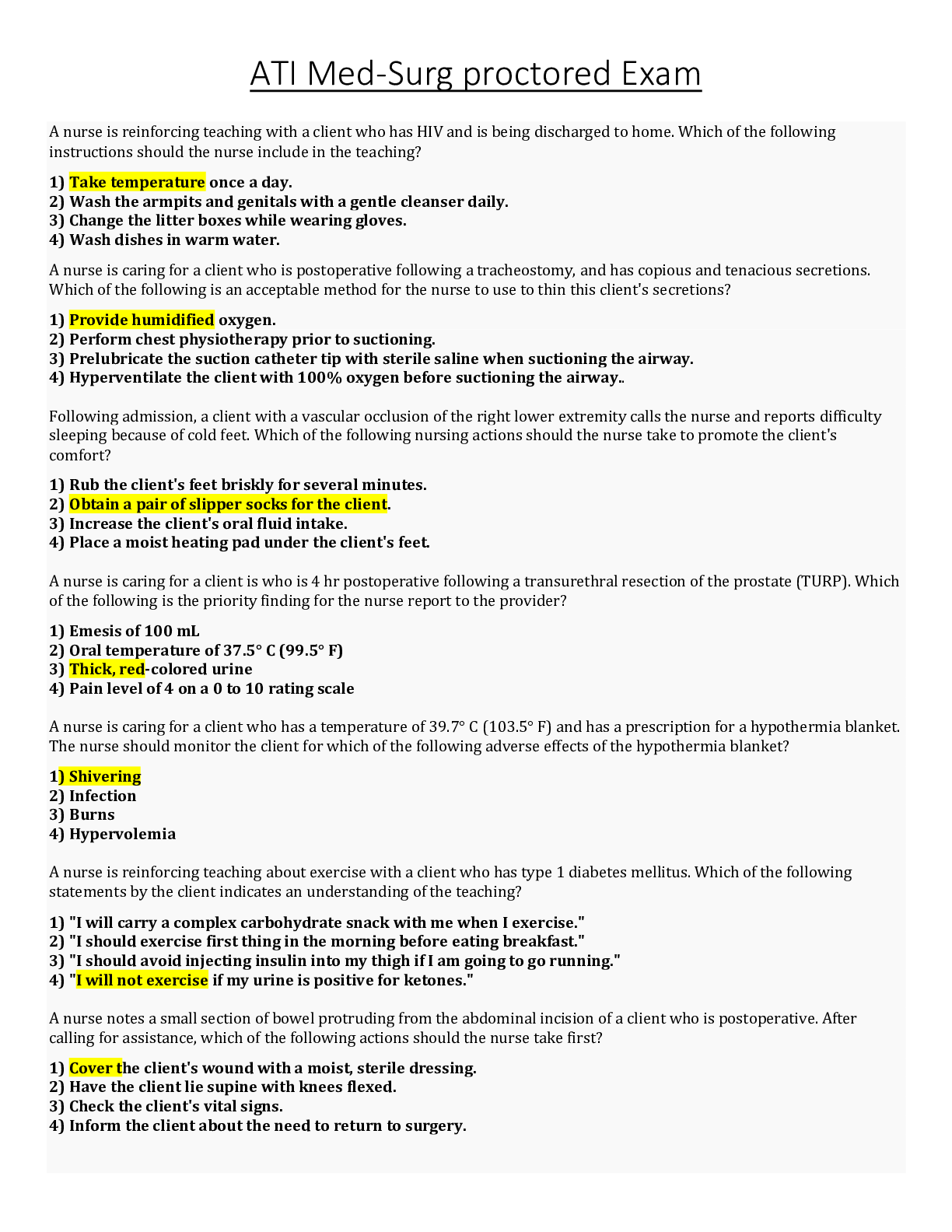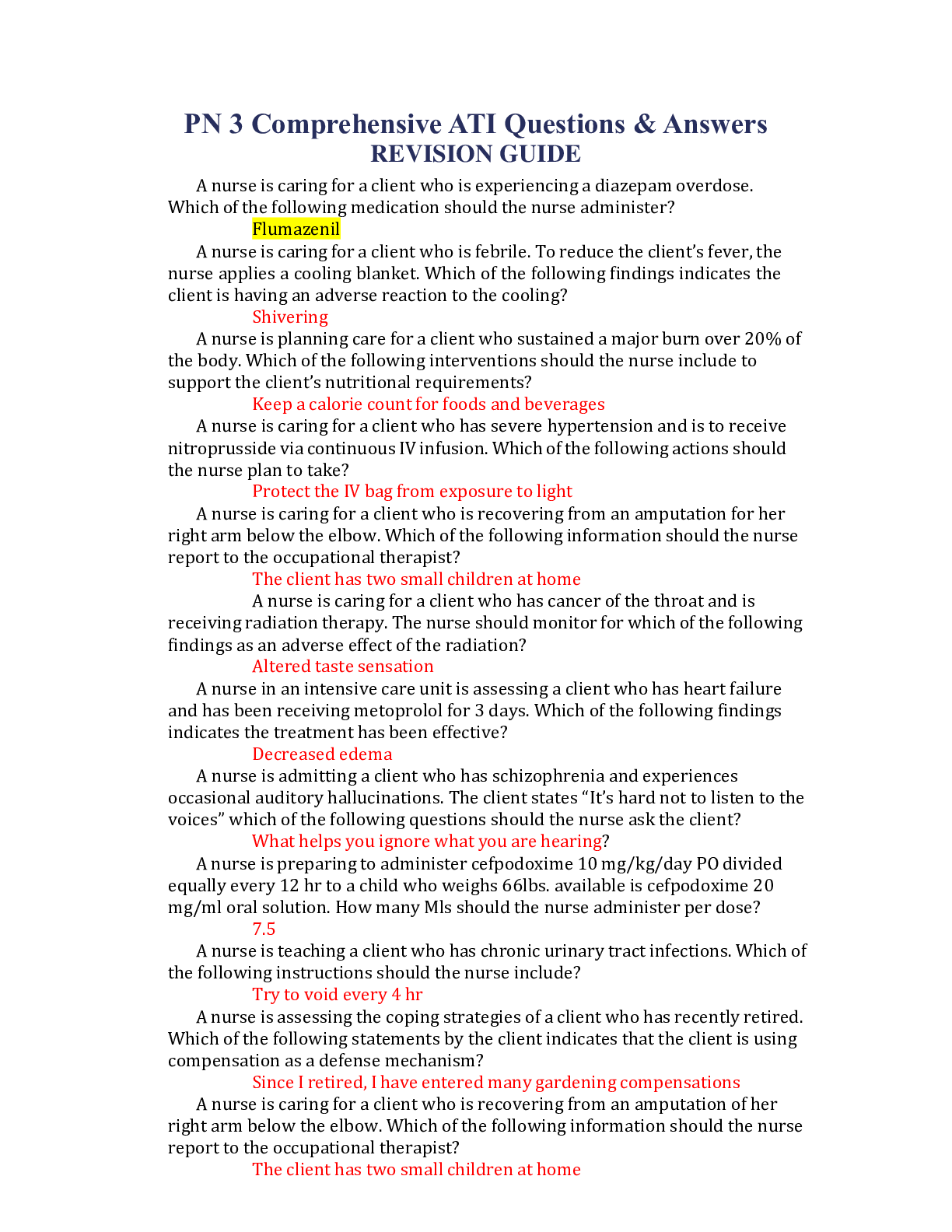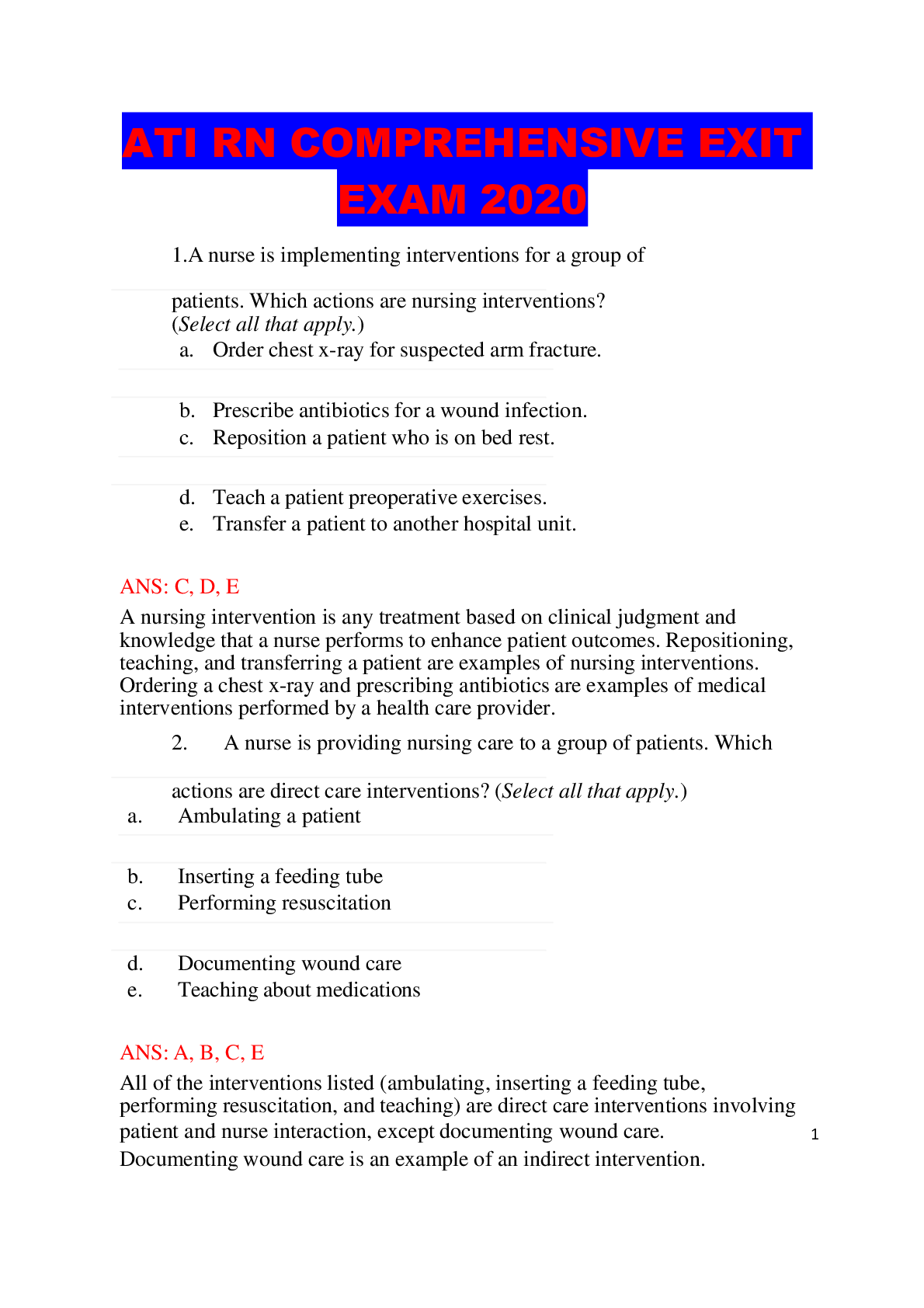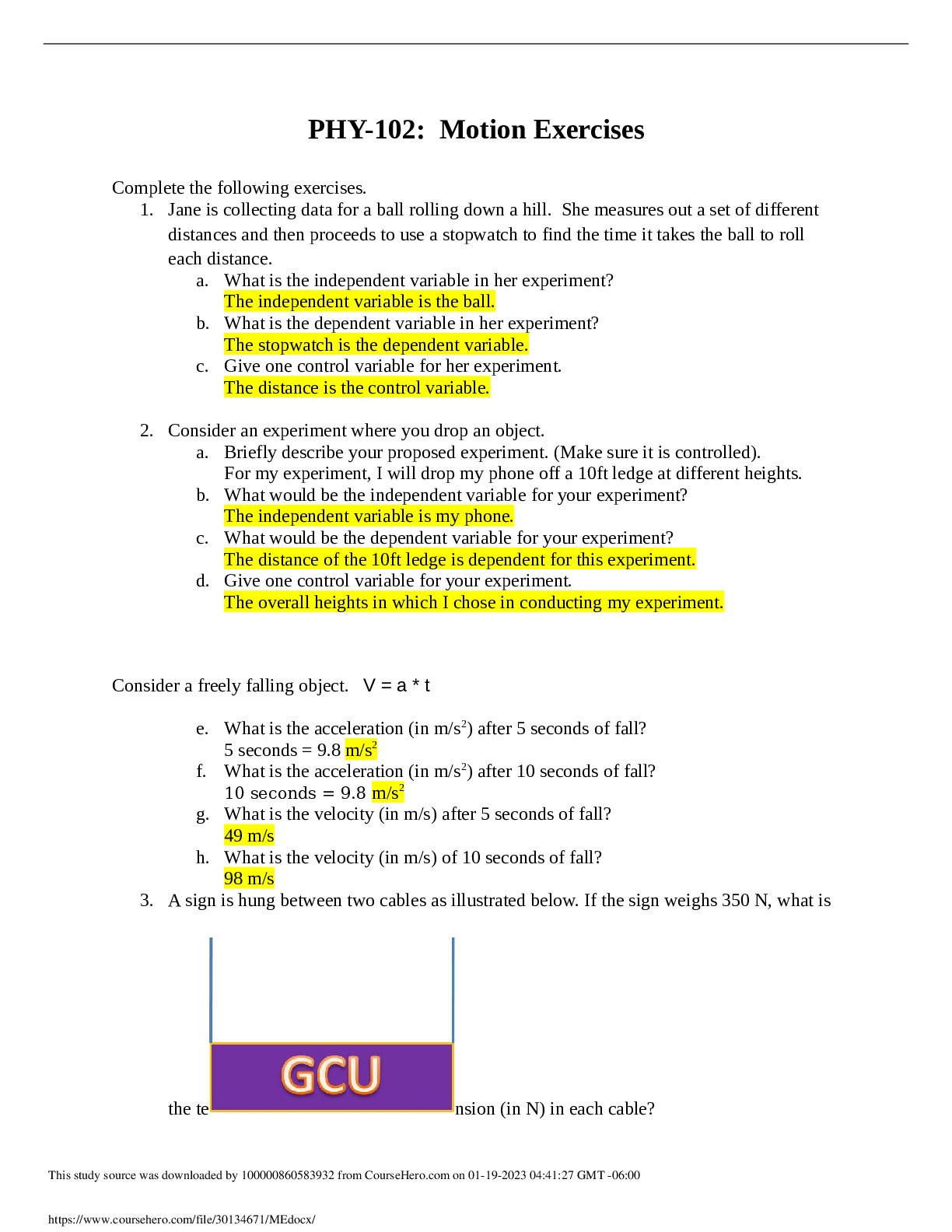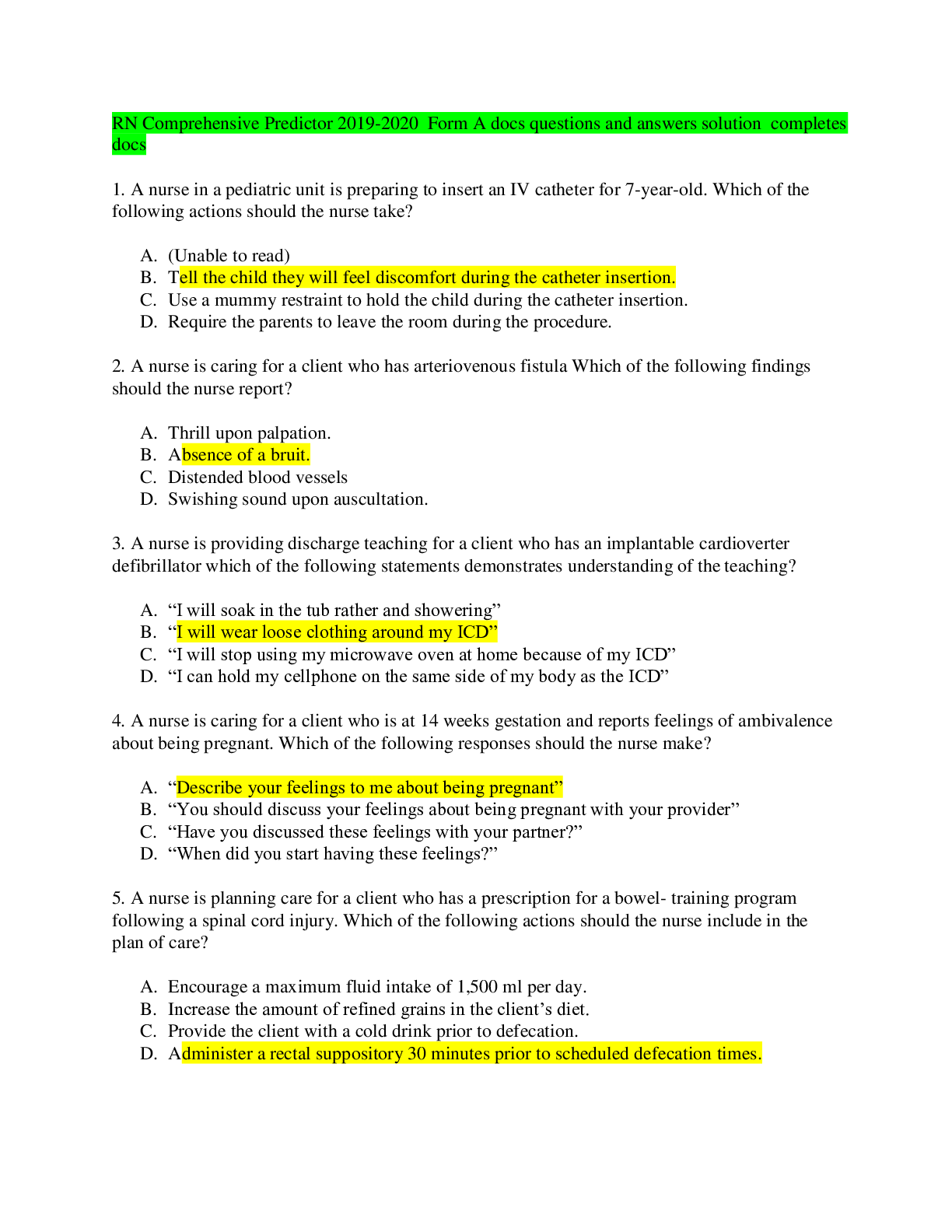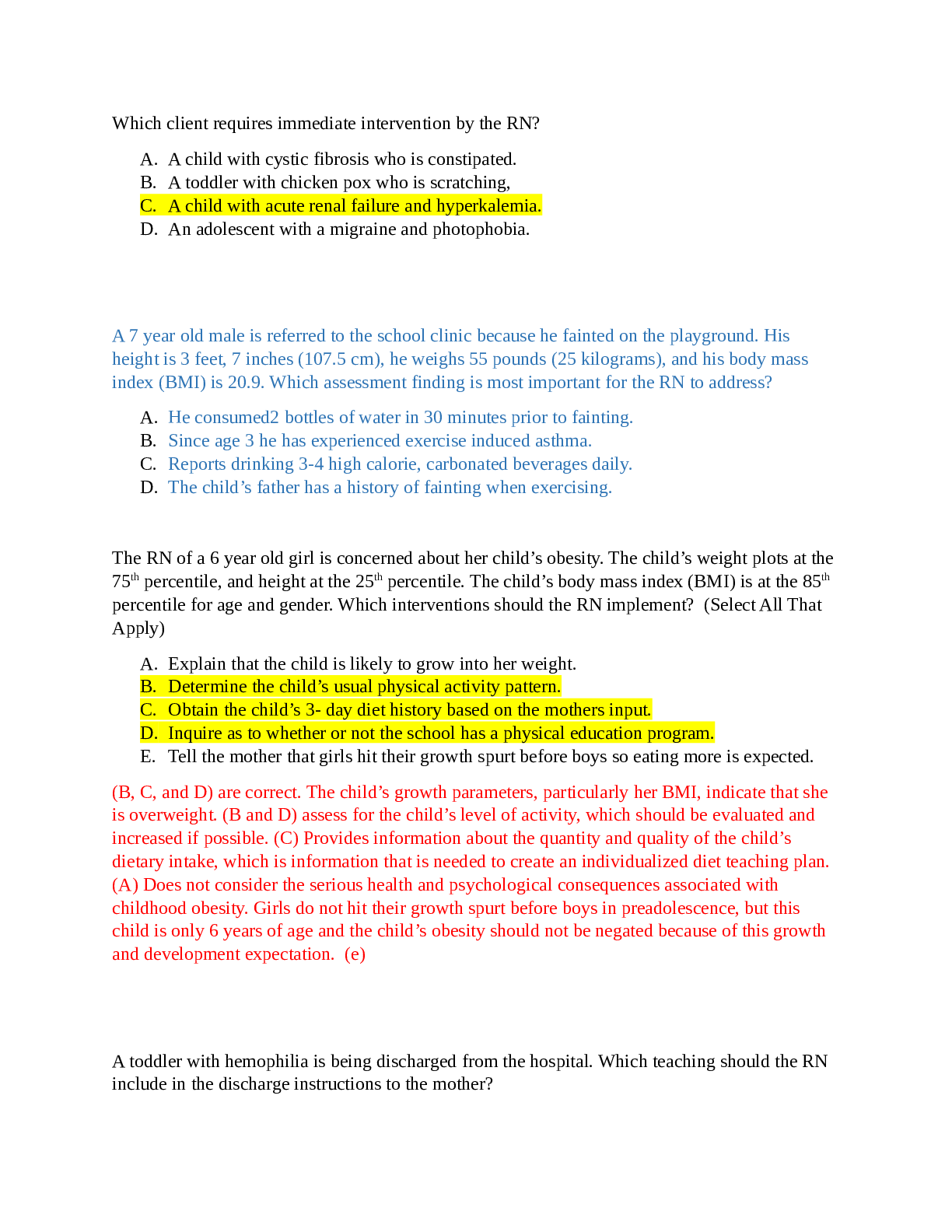Keiser University NURSING MISC CM_4_Exam_5_update 2021
Document Content and Description Below
Keiser University NURSING MISC CM_4_Exam_5_update 2021 CM Exam 5 1.A nurse is reviewing a client’s laboratory results and finds the hemoglobin is 10 g/dL and the hematocrit is 30%. The nurse rec... ognizes that the client is at risk for which of the following? a. Impaired immunity b. Prolonged bleeding c. Cellular hypoxia d. Fluid retention 2. A nurse is caring for an older adult client who has a urinary tract infection (UTI). Which of the following manifestations should the nurse identify as a finding specifically associated with this client? a. Confusion b. Low back pain c. Urinary retention d. Incontinence 3. A nurse is caring for a client who has chronic kidney disease (CKD) and states she has heartburn. The provider prescribes aluminum hydroxide. The client asks, "Why can't I just take the antacid magaldrate my husband has at home?" The nurse explains to the client that aluminum hydroxide is the preferred antacid because it lowers which of the following? a. Serum magnesium levels b. Serum potassium levels c. Serum phosphorus levels d. Serum calcium levels 4.A nurse is teaching a client following a cystoscopy about his new prescription for tamsulosin. Which of the following adverse effects should the nurse include in the teaching? a. Dizziness. b. Bradycardia c. Burning with urination d. Temporary loss of libido. 5.A nurse is providing teaching to a client about measures to prevent urinary tract infections (UTIs). Which of the following client statements indicates a need for further teaching? a. "I will need to wipe my perineal area from back to front after urination." b. "I will need to empty my bladder regularly and completely." c. "I need to drink 8 cups of liquid each day." d. "I will need to drink apple cider vinegar each day." 6.A nurse is caring for a client who has acute kidney injury (AKI). Which of the following arterial blood gas values would the nurse expect this client to have? a. pH 7.49, HCO3 24, PaCO2 30 b. pH 7.26, HCO3 14, PaCO2 30 (metabolic acidosis) c. pH 7.26, HCO3 24, PaCO2 46 d. pH 7.49, HCO3 30, PaCO2 40 7.A nurse is caring for a young female adult client who reports weakness, fatigue, and heavy menstrual periods. The client has a hemoglobin level of 8 g/dL and a hematocrit level of 28 g/dL. The nurse suspect which of the following types of anemia? a. Sickle cell anemia b. Pernicious anemia c. Iron-deficiency anemia d. Folic acid deficiency anemia 8.A nurse is teaching a client who has acute kidney disease about fluid restrictions. Which of the following statements by the client should the nurse identify as understanding of the teaching? a. "I will make a list of my favorite beverages." b. "I will put beverages in large containers to give the appearance of drinking a lot." c. "I should consume most of the fluid during the evening." d. "I will not add ice cream to the amount of fluid intake." 9.A nurse is discussing kidney transplant with a client who has end-stage renal disease (ESRD). Which of the following should the nurse identify as a contraindication for this treatment? a) Breast cancer survivor for 8 years b) Pacemaker c) Alcohol use disorder d) 65-years of age 10.A nurse is monitoring an older adult female client who had a myocardial infarction (MI) for the development of an acute kidney injury. Which of the following findings should the nurse identify as indicating an increased risk of acute kidney injury (AKI)? a) Serum Osmolality 290 mOsm/kg Hâ O b) Magnesium 2.0 mEq/L c) Serum creatinine 1.8 mg/dL d) Blood urea nitrogen (BUN) 20mg/dL 11.A nurse is caring for a client who the provider suspects might have pernicious anemia. The nurse should expect the provider to prescribe which of the following diagnostic tests? a) Sweat test b) Haptoglobin c) Antinuclear antibodies d) Schilling test 12.A nurse is reviewing laboratory findings for four clients. Which of the following clients has manifestations of acute kidney injury? a) Hemoglobin 16 g/dL b) Serum creatinine 6 mg/dL c) BUN 15 mg/dL d) Serum potassium 4.5 mEq/L 13.A nurse is teaching a client who has a vitamin K deficiency about the effects of vitamin K. Which of the following information should the nurse include in the teaching? a) Vitamin K is produced in the liver. b) Vitamin K reverses warfarin toxicity. c) Vitamin K is produced in the gastric juices. d) Vitamin K promotes fibrinogen formation. 14.A nurse is reviewing the laboratory values of a client who has chronic glomerulonephritis. Which of the following is an expected finding for this client? a) RBC 4.9 mm3 b) Serum creatinine 0.8 mg/dL c) Serum potassium 4.0 mEq/L d) BUN 100 mg/dL 15.A nurse is caring for a male client who has chronic glomerulonephritis. Which of the following findings should the nurse expect? a) BUN 15 mg/dL b) Serum creatinine 7 mg/dL c) Urine specific gravity 1.035 d) Creatinine clearance 120 mL/min 16.A nurse is providing teaching to a client who has nephrotic syndrome. The nurse should recognize that which of the following client statements indicates a need for further teaching? a) "I will lose protein in my urine." b) "I can expect to have swelling in my face." c) "I should increase my sodium intake." d) "I should expect my provider to prescribe a kidney biopsy." 17.A nurse is teaching a client scheduled for an activated partial thromboplastin time (aPTT). Which of the following statements by the client indicates an understanding of the teaching? a) "It measures deficiencies in clotting factors." b) "This test will help my provider adjust my warfarin dosages." c) "I will need to skip breakfast until after the test is complete." d) "If my levels are too low, I am at an increased risk for bleeding." 18.A nurse is creating a dietary plan for an adult female client who has a hemoglobin level of 9.8 g/dL. Which of the following foods should the nurse recommend? a) Orange juice b) Carrots c) Raisins d) Maple syrup 19.A nurse is caring for a client who has nephrotic syndrome and is receiving high-dose corticosteroid therapy. For which of the following electrolyte imbalances should the nurse monitor? a) Hyperkalemia b) Hypermagnesemia c) Hypomagnesemia d) Hypokalemia 20.A nurse is teaching a client who has chronic kidney disease about limiting foods that are high in potassium. Which of the following foods should the nurse instruct the client to avoid? (Select all that apply.) A) Tomatoes B) Asparagus C) Raisins D) Bananas E) Green Beans 21.A nurse is reviewing the laboratory results of a client who has acute leukemia and received an aggressive chemotherapy treatment 10 days ago. Which of the following hematologic laboratory values should the nurse expect? (Select all that apply.) a) Increased hemoglobin count b) Decreased erythrocyte count c) Increased platelet count d) Decreased leukocyte count e) Decreased platelet count 22.A nurse is monitoring a client who is receiving packed RBCs. The nurse identifies which of the following as an expected finding? a) The blood has been infusing steadily for 5 hr with no client symptoms. b) The drip chamber with filter is filled completely with blood. c) A medication is being administered IV through the injection site closest to the client. d) The packed RBCs are connected by Y tubing to normal saline. 23.A nurse is reviewing a client's laboratory values. Which of the following values should the nurse report to the provider? a) Hgb 14.7 g/dL b) Platelets 160,000/mm3 c) Hct 45% d) WBC 1,700/mm3 24. A nurse is caring for a client who has end-stage renal disease (ESRD). Which of the following are expected findings? (Select all that apply). A) Hypotension B) Pruritus C) Bone pain D) Slurred speech E) Bradypnea. 25.A nurse is caring for a client who has chronic glomerulonephritis. The nurse should expect to find a decrease in which of the following serum laboratory values? a) Phosphate b) Potassium c) RBC d) Creatinine 26.A nurse assesses a patient’s peripheral IV site, and notices edema and tenderness above the site. What action will the nurse take next? a) Apply cold compresses to the IV site. b) Elevate the extremity on a pillow. c) Flush the catheter with normal saline. d) Stop the infusion of intravenous fluids. 27.A nurse is assessing a client who is postoperative and has anemia due to excess blood loss following surgery. Which of the following findings should the nurse expect? a) Bradycardia b) Hypertension c) Diarrhea d) Fatigue 28.A nurse is caring for a client who has end-stage kidney disease (ESKD) and reports having shortness of breath and swelling in his lower extremities. Upon assessment, the nurse notes the client has crackles in his lungs and an elevated blood pressure. The nurse should suspect which of the following based on the client's manifestations? a) Hypovolemia b) Hypervolemia c) Hyperkalemia d) Hyponatremia Answer B? 29.A nurse is caring for a client who has polycystic kidney disease (PKD). Which of the following findings should the nurse expect? a) Urinary retention b) Confusion c) Flank pain d) Hypotension 30.A nurse is planning care for a client who has pernicious anemia. Which of the following interventions should the nurse plan to implement? a) Iron supplements b) Vitamin B12 injections c) Vitamin B6 supplements d) Blood transfusions 31.A nurse is teaching a client who has a new diagnosis of aplastic anemia. Which of the following information should the nurse include in the teaching? a) Aplastic anemia results in an increased rate of RBC destruction. b) Aplastic anemia is associated with a decreased intake of iron. c) Aplastic anemia results in an inability to absorb vitamin B12. d) Aplastic anemia results from decreased bone marrow production of RBCs. 32.A nurse is assessing an older adult client who reports a sudden onset of urinary incontinence. The nurse should recognize which of the following conditions can cause incontinence in the older adult client? a) Uremia b) Cystitis c) Nephrosclerosis d) Diverticulitis 33.A nurse is teaching a client who has chronic kidney failure about planning a low-protein diet. The client states, "Why do I have to be concerned about protein?" Which of the following responses should the nurse make? a) "A low-protein diet reduces the risk for uremia." b) "A low -protein diet will reduce the risk for hyperkalemia." c) "A low-protein diet reduces the risk for edema." d) "A low-protein diet will increase the nitrogenous wastes in the blood." CIRRHOSIS AND PANCREATITIS PRACTICE 1.A nurse is preparing to administer three liquid medications to a client who has an NG tube with intermittent suction. Which of the following actions should the nurse take? A. Mix the three medications together prior to administering. B. Dilute each medication with 10 mL of tap water. C. Reattach the suction directly after administering the medication. D. Pinch the tube prior to attaching the medication syringe. After detaching the NG tube from the suction tubing, the nurse should pinch or kink the tube to prevent distention from air entering the tube 2.A nurse is reviewing the laboratory data of a client who has acute pancreatitis. The nurse should expect to find an elevation of which of following values? A. Calcium B. RBC count C. Magnesium D. Amylase Amylase is an enzyme that changes complex sugars into simple sugars that can be used by the body. It is produced by the pancreas and salivary glands and released into the mouth, stomach, and intestines to aid in digestion. The amylase level of a client who has acute pancreatitis usually increases within 12 to 24 hr and can remain elevated for 2 to 3 days. 3.A nurse is caring for a client who has chronic kidney disease (CKD) and states she has heartburn. The provider prescribes aluminum hydroxide. The client asks, "Why can't I just take the antacid magaldrate my husband has at home?" The nurse explains to the client that aluminum hydroxide is the preferred antacid because it lowers which of the following? A. Serum phosphorus levels B. Serum potassium levels C. Serum magnesium levels D. Serum calcium levels Aluminum-based formulas are also a phosphate binder, helping to lower serum phosphorus levels in clients who have CKD. 4. A nurse is planning care for a client who has cirrhosis and ascites. Which of the following interventions should the nurse include in the plan of care? A. Decrease the client’s fluid intake. B. Increase the client’s saturated fat intake. C. Increase the client’s sodium intake. D. Decrease the client’s carbohydrate intake. The nurse should restrict fluids for a client who has cirrhosis and ascites due to the client’s risk for increased fluid retention. 5.A nurse is providing teaching to a client who has a history of pancreatitis. Which of the following food choices should the nurse instruct the client to avoid? A. Noodles B. B. Vegetable soup C. Baked fish D. Cheddar cheese Clients who have pancreatitis should avoid foods high in fat. Cheddar cheese is high in fat content and the client should avoid this food choice. 6. A nurse is providing discharge teaching for a client who has chronic pancreatitis. Which of the following statements should the nurse make? A. “You should decrease your caloric intake when abdominal pain is present.” B. “You should increase your daily intake of protein.” C. “You should increase fat intake when experiencing loose stools.” D. “You should limit alcohol intake to 2-3 drinks per week.” Clients who have chronic pancreatitis should consume a diet that is high in protein. 7. A nurse is providing discharge teaching for a client who has acute pancreatitis and has a prescription for fat-soluble vitamin supplements. The nurse should instruct the client to take a supplement for which of the following? A. Vitamin A B. Vitamin B1 C. Vitamin C D. Vitamin B12 The nurse should instruct the client that fat-soluble vitamins include vitamins A, D, E, and K. 8. A nurse is caring for a client who came to the emergency department with abdominal distention and is now on the medical-surgical unit with an NG tube in place to low gastric suction. The client is reporting anxiety, discomfort, and a feeling of bloating. Which of the following actions is the nurse's priority? A. Request a prescription for a medication to ease the client's anxiety. B. Irrigate the NG tube with 100 mL of sterile water. C. Check to see if the suction equipment is working. D. Remove and reinsert the NG tube. The first action the nurse should take using the nursing process is to assess the situation. The nurse should check for the most obvious reason why the client's symptoms have returned. If the suction equipment has malfunctioned, the nurse should adjust it or replace it with working equipment. 9. A nurse is teaching a client who has a new prescription for pancrelipase to aid in digestion. The nurse should inform the client to expect which of the following gastrointestinal changes? A. Decreased mucus in stools B. Decreased black tarry stools. C. Decreased watery stools D. Decreased fat in stools Pancrelipase is a combination of pancreatic enzymes used to increase digestion of fats, carbohydrates and proteins. The client should expect a reduction of fat in stools. 10. A nurse is caring for a client who has liver cirrhosis with ascites, bleeding esophageal varices, and portal hypertension. The nurse recognizes which of the following laboratory findings as indicating the client’s gastrointestinal (GI) tract is digesting and absorbing blood? A. Elevated blood urea nitrogen (BUN) B. Elevated HbA1c C. Decreased chloride D. Decreased bilirubin As the body digests blood, BUN rises. An elevated BUN is an indication of GI bleeding. 11. A nurse is caring for a client who has impaired renal function. For which of the following findings should the nurse notify the provider? A. Urine output of175 mL in the past 8 hr B. Urine output of 2,200 mL in the past 24 hr C. First-voided urine in the morning has a strong odor D. Urine is cloudy after sitting in the urinal for 6 hr The nurse should notify the provider if the client’s urinary output is less than 30 mL/hr. This finding indicates a fluid imbalance, decreased circulating fluid volume, and possibly inadequate renal perfusion. 12. A nurse is caring for a client and observes that the client’s urine is dark amber, cloudy, and has an unpleasant odor. The nurse should recognize that these findings are associated with which of the following? A. Urinary tract infection B. Urinary incontinence C. Urinary frequency D. Urinary retention A client who has a urinary tract infection has urine that appears cloudy and concentrated because of the presence of WBCs, RBCs and bacteria. The urine often has an unpleasant odor. 13.A nurse is caring for a client who has cirrhosis and a new prescription for lactulose. Which of the following manifestations indicates an adverse effect of the medication? A. Dry mouth B. Vomiting C. Headache D. Peripheral edema The nurse will monitor for vomiting as an adverse effect of lactulose. 14.A nurse is interviewing a client who has acute pancreatitis. Which of the following factors should the nurse anticipate finding in the client's history? A. Gallstones B. Hypolipidemia C. COPD D. Diabetes mellitus The client's history might reveal biliary obstruction from a gallstone causing bile to inflame the pancreas. 15. A nurse is planning care for a client who has cirrhosis of the liver. Which of the following actions should the nurse include in the plan? (Select all that apply.) A. Administer furosemide. B. Administer warfarin. C. Implement a low-sodium diet. D. Measure the client's abdominal girth. E. Encourage weight lifting during physical therapy. Administer furosemide is correct. The nurse should administer furosemide to the client to reduce fluid accumulation in the abdomen. Administer warfarin is incorrect. The nurse should avoid administering warfarin to the client due to possible destruction of platelets caused by splenomegaly, which can result in spontaneous bleeding. Propranolol is prescribed instead to discourage bleeding. Implement a low-sodium diet is correct. The nurse should implement a low-sodium diet to control fluid accumulation in the abdomen. Measure the client's abdominal girth is correct. The nurse should measure the client's abdominal girth. Daily weights are an even more reliable indicator of fluid accumulation. Encourage weight lifting during physical therapy is incorrect. The nurse should understand weight lifting can cause bleeding. 16. A nurse is caring for a client who has gastrointestinal bleeding. Which of the following actions should the nurse take first? A. Assess orthostatic blood pressure. B. Explain the procedure for an upper gastrointestinal series. C. Administer pain medication. D. Test the client's emesis for blood. Using the nursing process, the first action the nurse should take is to assess the client by measuring the client's orthostatic blood pressure. This action determines if the client is hypovolemic and establishes a baseline for further measurements. 17.A nurse is assessing a client who has advanced cirrhosis. Which of the following manifestations should the nurse expect? A. Petechiae B. Hypertension C. Osteoarthritis D. Peripheral ulcers A manifestation of advanced cirrhosis is petechiae due to impaired coagulation from a dysfunctional liver. 18.A nurse is performing gastric lavage on a client using a large-bore NG tube. Which of the following actions should the nurse take? A. Instill 500 mL of sterile saline. B. Position the client on her right side. C. Withdraw fluid until it is clear. D. Connect the NG tube to intermittent suction. The nurse should continue to instill and withdraw the lavage fluid until it is clear. 19.A nurse is caring for a client who has an active upper gastrointestinal bleed. After inserting a NG tube into the client, which of the following findings should the nurse anticipate? A. Frothy pink drainage B. Dark amber drainage C. Coffee-ground drainage D. Greenish-yellow drainage "Coffee-ground" drainage or emesis indicates the presence of blood. The coffee ground appearance is the result of the effects of methemoglobin on the hemoglobin. 20. A nurse is reviewing the medical record of a client who reports drinking three to four glasses of wine each night and taking 3,000 mg of acetaminophen daily. Which of the following laboratory values is the priority for the nurse to assess? A. Amylase B. Creatinine C. Aspartate aminotransferase (AST) D. Antidiuretic hormone (ADH) The greatest risk to this client is liver injury from the combined adverse effects of alcohol and acetaminophen. Therefore, the priority laboratory value for the nurse to evaluate is AST because an elevated level is an indication of liver damage. [Show More]
Last updated: 2 years ago
Preview 1 out of 9 pages
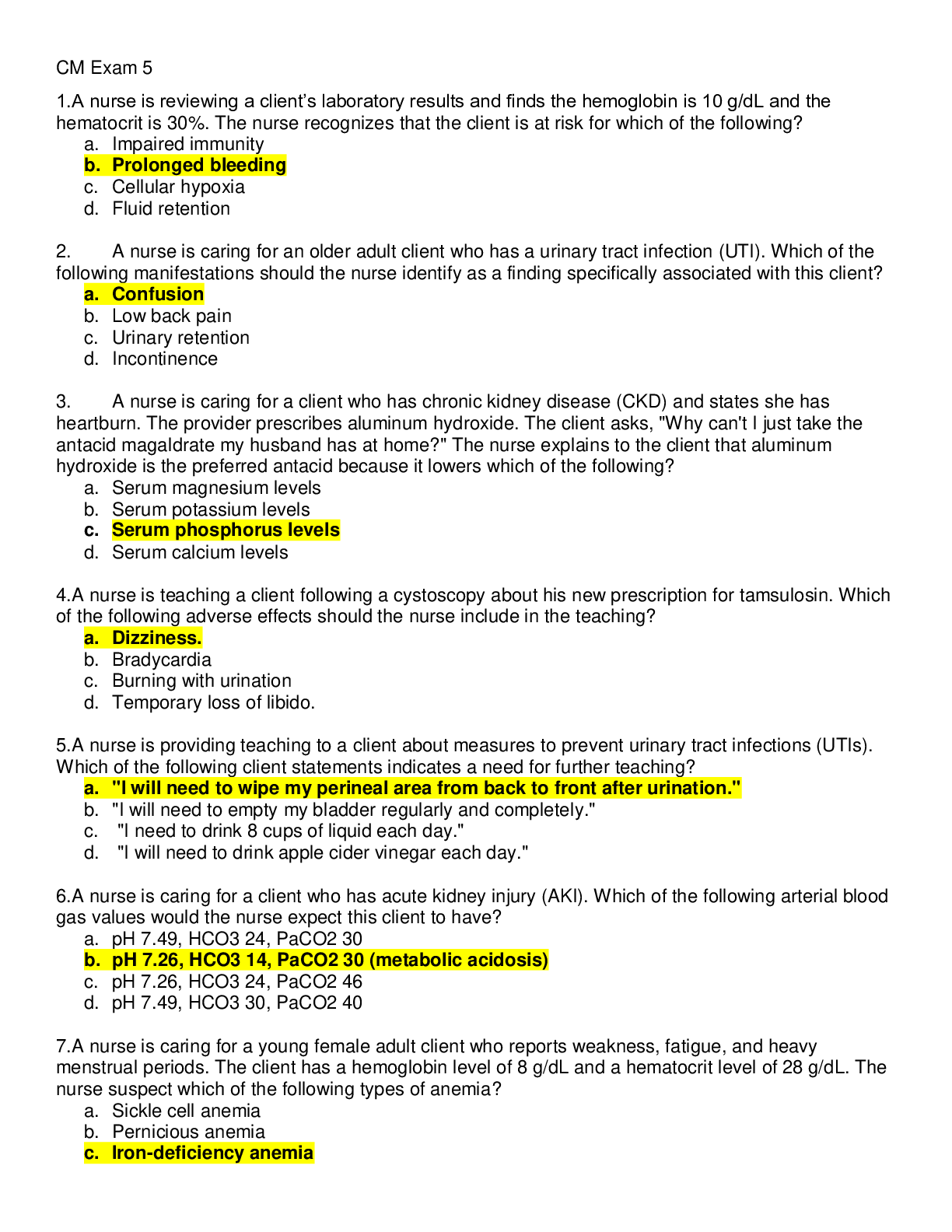
Buy this document to get the full access instantly
Instant Download Access after purchase
Buy NowInstant download
We Accept:

Reviews( 0 )
$10.00
Can't find what you want? Try our AI powered Search
Document information
Connected school, study & course
About the document
Uploaded On
Jan 17, 2021
Number of pages
9
Written in
Additional information
This document has been written for:
Uploaded
Jan 17, 2021
Downloads
0
Views
127

